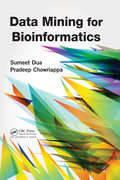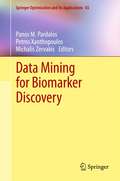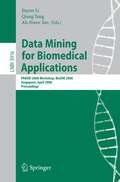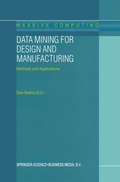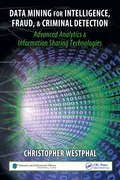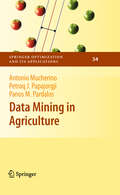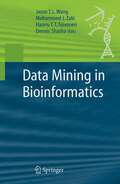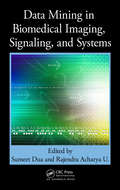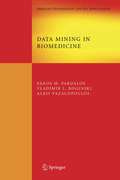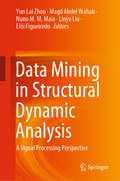- Table View
- List View
Data Mining and Exploration: From Traditional Statistics to Modern Data Science
by Chong Ho Alex YuThis book introduces both conceptual and procedural aspects of cutting-edge data science methods, such as dynamic data visualization, artificial neural networks, ensemble methods, and text mining. There are at least two unique elements that can set the book apart from its rivals. First, most students in social sciences, engineering, and business took at least one class in introductory statistics before learning data science. However, usually these courses do not discuss the similarities and differences between traditional statistics and modern data science; as a result learners are disoriented by this seemingly drastic paradigm shift. In reaction, some traditionalists reject data science altogether while some beginning data analysts employ data mining tools as a “black box”, without a comprehensive view of the foundational differences between traditional and modern methods (e.g., dichotomous thinking vs. pattern recognition, confirmation vs. exploration, single method vs. triangulation, single sample vs. cross-validation etc.). This book delineates the transition between classical methods and data science (e.g. from p value to Log Worth, from resampling to ensemble methods, from content analysis to text mining etc.). Second, this book aims to widen the learner's horizon by covering a plethora of software tools. When a technician has a hammer, every problem seems to be a nail. By the same token, many textbooks focus on a single software package only, and consequently the learner tends to fit the problem with the tool, but not the other way around. To rectify the situation, a competent analyst should be equipped with a tool set, rather than a single tool. For example, when the analyst works with crucial data in a highly regulated industry, such as pharmaceutical and banking, commercial software modules (e.g., SAS) are indispensable. For a mid-size and small company, open-source packages such as Python would come in handy. If the research goal is to create an executive summary quickly, the logical choice is rapid model comparison. If the analyst would like to explore the data by asking what-if questions, then dynamic graphing in JMP Pro is a better option. This book uses concrete examples to explain the pros and cons of various software applications.
Data Mining and Exploration: From Traditional Statistics to Modern Data Science
by Chong Ho Alex YuThis book introduces both conceptual and procedural aspects of cutting-edge data science methods, such as dynamic data visualization, artificial neural networks, ensemble methods, and text mining. There are at least two unique elements that can set the book apart from its rivals. First, most students in social sciences, engineering, and business took at least one class in introductory statistics before learning data science. However, usually these courses do not discuss the similarities and differences between traditional statistics and modern data science; as a result learners are disoriented by this seemingly drastic paradigm shift. In reaction, some traditionalists reject data science altogether while some beginning data analysts employ data mining tools as a “black box”, without a comprehensive view of the foundational differences between traditional and modern methods (e.g., dichotomous thinking vs. pattern recognition, confirmation vs. exploration, single method vs. triangulation, single sample vs. cross-validation etc.). This book delineates the transition between classical methods and data science (e.g. from p value to Log Worth, from resampling to ensemble methods, from content analysis to text mining etc.). Second, this book aims to widen the learner's horizon by covering a plethora of software tools. When a technician has a hammer, every problem seems to be a nail. By the same token, many textbooks focus on a single software package only, and consequently the learner tends to fit the problem with the tool, but not the other way around. To rectify the situation, a competent analyst should be equipped with a tool set, rather than a single tool. For example, when the analyst works with crucial data in a highly regulated industry, such as pharmaceutical and banking, commercial software modules (e.g., SAS) are indispensable. For a mid-size and small company, open-source packages such as Python would come in handy. If the research goal is to create an executive summary quickly, the logical choice is rapid model comparison. If the analyst would like to explore the data by asking what-if questions, then dynamic graphing in JMP Pro is a better option. This book uses concrete examples to explain the pros and cons of various software applications.
Data Mining and Knowledge Discovery for Process Monitoring and Control (Advances in Industrial Control)
by Xue Z. WangModern computer-based control systems are able to collect a large amount of information, display it to operators and store it in databases but the interpretation of the data and the subsequent decision making relies mainly on operators with little computer support. This book introduces developments in automatic analysis and interpretation of process-operational data both in real-time and over the operational history, and describes new concepts and methodologies for developing intelligent, state space-based systems for process monitoring, control and diagnosis. The book brings together new methods and algorithms from process monitoring and control, data mining and knowledge discovery, artificial intelligence, pattern recognition, and causal relationship discovery, as well as signal processing. It also provides a framework for integrating plant operators and supervisors into the design of process monitoring and control systems.
Data Mining for Bioinformatics
by Sumeet Dua Pradeep ChowriappaCovering theory, algorithms, and methodologies, as well as data mining technologies, Data Mining for Bioinformatics provides a comprehensive discussion of data-intensive computations used in data mining with applications in bioinformatics. It supplies a broad, yet in-depth, overview of the application domains of data mining for bioinformatics to he
Data Mining for Bioinformatics
by Sumeet Dua Pradeep ChowriappaCovering theory, algorithms, and methodologies, as well as data mining technologies, Data Mining for Bioinformatics provides a comprehensive discussion of data-intensive computations used in data mining with applications in bioinformatics. It supplies a broad, yet in-depth, overview of the application domains of data mining for bioinformatics to he
Data Mining for Biomarker Discovery (Springer Optimization and Its Applications #65)
by Panos M. Pardalos Petros Xanthopoulos Michalis ZervakisBiomarker discovery is an important area of biomedical research that may lead to significant breakthroughs in disease analysis and targeted therapy. Biomarkers are biological entities whose alterations are measurable and are characteristic of a particular biological condition. Discovering, managing, and interpreting knowledge of new biomarkers are challenging and attractive problems in the emerging field of biomedical informatics.This volume is a collection of state-of-the-art research into the application of data mining to the discovery and analysis of new biomarkers. Presenting new results, models and algorithms, the included contributions focus on biomarker data integration, information retrieval methods, and statistical machine learning techniques.This volume is intended for students, and researchers in bioinformatics, proteomics, and genomics, as well engineers and applied scientists interested in the interdisciplinary application of data mining techniques.
Data Mining for Biomedical Applications: PAKDD 2006 Workshop, BioDM 2006, Singapore, April 9, 2006, Proceedings (Lecture Notes in Computer Science #3916)
by Jinyan Li Qiang Yang Ah-Hwee TanThis book constitutes the refereed proceedings of the International Workshop on Data Mining for Biomedical Applications, BioDM 2006, held in Singapore in conjunction with the 10th Pacific-Asia Conference on Knowledge Discovery and Data Mining (PAKDD 2006). The 14 revised full papers presented together with one keynote talk were carefully reviewed and selected from 35 submissions. The papers are organized in topical sections
Data Mining for Design and Manufacturing: Methods and Applications (Massive Computing #3)
by D. BrahaData Mining for Design and Manufacturing: Methods and Applications is the first book that brings together research and applications for data mining within design and manufacturing. The aim of the book is 1) to clarify the integration of data mining in engineering design and manufacturing, 2) to present a wide range of domains to which data mining can be applied, 3) to demonstrate the essential need for symbiotic collaboration of expertise in design and manufacturing, data mining, and information technology, and 4) to illustrate how to overcome central problems in design and manufacturing environments. The book also presents formal tools required to extract valuable information from design and manufacturing data, and facilitates interdisciplinary problem solving for enhanced decision making. Audience: The book is aimed at both academic and practising audiences. It can serve as a reference or textbook for senior or graduate level students in Engineering, Computer, and Management Sciences who are interested in data mining technologies. The book will be useful for practitioners interested in utilizing data mining techniques in design and manufacturing as well as for computer software developers engaged in developing data mining tools.
Data Mining for Intelligence, Fraud & Criminal Detection: Advanced Analytics & Information Sharing Technologies
by Christopher WestphalIn 2004, the Government Accountability Office provided a report detailing approximately 200 government-based data-mining projects. While there is comfort in knowing that there are many effective systems, that comfort isn‘t worth much unless we can determine that these systems are being effectively and responsibly employed.Written by one of the most
Data Mining for Systems Biology: Methods and Protocols (Methods in Molecular Biology #939)
by Hiroshi Mamitsuka, Charles DeLisi and Minoru KanehisaThe post-genomic revolution is witnessing the generation of petabytes of data annually, with deep implications ranging across evolutionary theory, developmental biology, agriculture, and disease processes. Data Mining for Systems Biology: Methods and Protocols, surveys and demonstrates the science and technology of converting an unprecedented data deluge to new knowledge and biological insight. The volume is organized around two overlapping themes, network inference and functional inference. Written in the highly successful Methods in Molecular Biology™ series format, chapters include introductions to their respective topics, lists of the necessary materials and reagents, step-by-step, readily reproducible protocols, and key tips on troubleshooting and avoiding known pitfalls. Authoritative and practical, Data Mining for Systems Biology: Methods and Protocols also seeks to aid researchers in the further development of databases, mining and visualization systems that are central to the paradigm altering discoveries being made with increasing frequency.
Data Mining for Systems Biology: Methods and Protocols (Methods in Molecular Biology #1807)
by Hiroshi MamitsukaThis fully updated book collects numerous data mining techniques, reflecting the acceleration and diversity of the development of data-driven approaches to the life sciences. The first half of the volume examines genomics, particularly metagenomics and epigenomics, which promise to deepen our knowledge of genes and genomes, while the second half of the book emphasizes metabolism and the metabolome as well as relevant medicine-oriented subjects. Written for the highly successful Methods in Molecular Biology series, chapters include the kind of detail and expert implementation advice that is useful for getting optimal results. Authoritative and practical, Data Mining for Systems Biology: Methods and Protocols, Second Edition serves as an ideal resource for researchers of biology and relevant fields, such as medical, pharmaceutical, and agricultural sciences, as well as for the scientists and engineers who are working on developing data-driven techniques, such as databases, data sciences, data mining, visualization systems, and machine learning or artificial intelligence that now are central to the paradigm-altering discoveries being made with a higher frequency.
Data Mining in Agriculture (Springer Optimization and Its Applications #34)
by Antonio Mucherino Petraq Papajorgji Panos M. PardalosData Mining in Agriculture represents a comprehensive effort to provide graduate students and researchers with an analytical text on data mining techniques applied to agriculture and environmental related fields. This book presents both theoretical and practical insights with a focus on presenting the context of each data mining technique rather intuitively with ample concrete examples represented graphically and with algorithms written in MATLAB®.
Data Mining in Bioinformatics (Advanced Information and Knowledge Processing)
by Jason T. L. Wang Mohammed J. Zaki Hannu Toivonen Dennis ShashaWritten especially for computer scientists, all necessary biology is explained. Presents new techniques on gene expression data mining, gene mapping for disease detection, and phylogenetic knowledge discovery.
Data Mining in Biomedical Imaging, Signaling, and Systems
by Rajendra Acharya U Sumeet DuaData mining can help pinpoint hidden information in medical data and accurately differentiate pathological from normal data. It can help to extract hidden features from patient groups and disease states and can aid in automated decision making. Data Mining in Biomedical Imaging, Signaling, and Systems provides an in-depth examination of the biomedi
Data Mining in Biomedical Imaging, Signaling, and Systems
by Rajendra Acharya U Sumeet DuaData mining can help pinpoint hidden information in medical data and accurately differentiate pathological from normal data. It can help to extract hidden features from patient groups and disease states and can aid in automated decision making. Data Mining in Biomedical Imaging, Signaling, and Systems provides an in-depth examination of the biomedi
Data Mining in Biomedicine (Springer Optimization and Its Applications #7)
by Panos M. Pardalos Vladimir L. Boginski Alkis VazacopoulosThis volume presents an extensive collection of contributions covering aspects of the exciting and important research field of data mining techniques in biomedicine. Coverage includes new approaches for the analysis of biomedical data; applications of data mining techniques to real-life problems in medical practice; comprehensive reviews of recent trends in the field. The book addresses incorporation of data mining in fundamental areas of biomedical research: genomics, proteomics, protein characterization, and neuroscience.
Data Mining in Clinical Medicine (Methods in Molecular Biology #1246)
by Carlos Fernández-Llatas and Juan Miguel García-GómezThis volume complies a set of Data Mining techniques and new applications in real biomedical scenarios. Chapters focus on innovative data mining techniques, biomedical datasets and streams analysis, and real applications. Written in the highly successful Methods in Molecular Biology series format, chapters are thought to show to Medical Doctors and Engineers the new trends and techniques that are being applied to Clinical Medicine with the arrival of new Information and Communication technologiesAuthoritative and practical, Data Mining in Clinical Medicine seeks to aid scientists with new approaches and trends in the field.
Data Mining in Crystallography (Structure and Bonding #134)
by D. W. M. Hofmann Liudmila N. KuleshovaHumans have been “manually” extracting patterns from data for centuries, but the increasing volume of data in modern times has called for more automatic approaches. Early methods of identifying patterns in data include Bayes’ theorem (1700s) and Regression analysis (1800s). The proliferation, ubiquity and incre- ing power of computer technology has increased data collection and storage. As data sets have grown in size and complexity, direct hands-on data analysis has - creasingly been augmented with indirect, automatic data processing. Data mining has been developed as the tool for extracting hidden patterns from data, by using computing power and applying new techniques and methodologies for knowledge discovery. This has been aided by other discoveries in computer science, such as Neural networks, Clustering, Genetic algorithms (1950s), Decision trees (1960s) and Support vector machines (1980s). Data mining commonlyinvolves four classes of tasks: • Classi cation: Arranges the data into prede ned groups. For example, an e-mail program might attempt to classify an e-mail as legitimate or spam. Common algorithmsinclude Nearest neighbor,Naive Bayes classi er and Neural network. • Clustering: Is like classi cation but the groups are not prede ned, so the algorithm will try to group similar items together. • Regression: Attempts to nd a function which models the data with the least error. A common method is to use Genetic Programming. • Association rule learning: Searches for relationships between variables. For example, a supermarket might gather data of what each customer buys.
Data Mining in Proteomics: From Standards to Applications (Methods in Molecular Biology #696)
by Michael Hamacher, Martin Eisenacher and Christian StephanThrough the rapid development of proteomics methods and technologies, an enormous amount of data was created, leading to a wide-spread rethinking of strategy design and data interpretation. In Data Mining in Proteomics: From Standards to Applications, experts in the field present these new insights within the proteomics community, taking the historical evolution as well as the most important international standardization projects into account. Along with basic and sophisticated overviews of proteomics technologies, standard data formats, and databases, the volume features chapters on data interpretation strategies including statistics, spectra interpretation, and analysis environments as well as specialized tasks such as data annotation, peak picking, phosphoproteomics, spectrum libraries, LC/MS imaging, and splice isoforms. As a part of the highly successful Methods in Molecular Biology™ series, this work provides the kind of detailed description and implementation advice that is crucial for getting optimal results. Authoritative and cutting-edge, Data Mining in Proteomics: From Standards to Applications is a well-balanced compendium for beginners and experts, offering a broad scope of data mining topics but always focusing on the current state-of-the-art and beyond.
Data Mining in Structural Biology: Signal Transduction and Beyond (Ernst Schering Foundation Symposium Proceedings #34)
by U. Egner I. SchlichtingStructural biology is becoming a routine technique for structure de termination in pharmaceutical industries. The advances in molecular biology, crystal handling and data collection techniques, tunable syn chrotron radiation sources, and high-performance computing have all contributed to developments such as the production and expression of tailored protein domains, the use of the MAD (Multiple Anomalous Dispersion) method, and the collection of X-ray data from tiny crystals at cryogenic temperature. The number of protein structures deposited in the Protein Databank has increased tremendously over the last 3-4 years. Since 1997, more than 1,500 structures have been deposited each year, and during the first 7 months of this year, 1,500 protein structures were already deposited. The numerous initiatives in the field of "structural genomics" distributed all over the world have led to the development of techniques for high-throughput structure determina tion, thereby contributing to the increase in the determination of three dimensional protein structures. This structural information is being ex plored in various ways in the drug discovery process. It is not only used in structure-based drug design of new low-molecular-weight li gands, but also in the early stages of target validation and assessment. With the number of protein sequences without significant homology to well-known proteins increasing, the technique of structure-sequence compatibility (threading) is increasingly used to assign a function to a given protein fold.
Data Mining in Structural Dynamic Analysis: A Signal Processing Perspective
by Yun Lai Zhou Magd Abdel Wahab Nuno M. M. Maia Linya Liu Elói FigueiredoThis book highlights the applications of data mining technologies in structural dynamic analysis, including structural design, optimization, parameter identification, model updating, damage identification, in civil, mechanical, and aerospace engineering. These engineering applications require precise structural design, fabrication, inspection, and further monitoring to obtain a full life-cycle analysis, and by focusing on data processing, data mining technologies offer another aspect in structural dynamic analysis. Discussing techniques in time/frequency domain, such as Hilbert transforms, wavelet theory, and machine learning for structural dynamic analysis to help in structural monitoring and diagnosis, the book is an essential reference resource for beginners, graduates and industrial professionals in various fields.
Data Mining Techniques for the Life Sciences (Methods in Molecular Biology #2449)
by Oliviero Carugo Frank EisenhaberThis third edition details new and updated methods and protocols on important databases and data mining tools. Chapters guides readers through archives of macromolecular sequences and three-dimensional structures, databases of protein-protein interactions, methods for prediction conformational disorder, mutant thermodynamic stability, aggregation, and drug response. Quality of structural data and their release, soft mechanics applications in biology, and protein flexibility are considered, too, together with pan-genome analyses, rational drug combination screening and Omics Deep Mining. Written in the format of the highly successful Methods in Molecular Biology series, each chapter includes an introduction to the topic, lists necessary materials, includes step-by-step, readily reproducible protocols. Authoritative and cutting-edge, Data Mining Techniques for the Life Sciences, Third Edition aims to be a practical guide to researches to help further their study in this field.
Data Mining Techniques for the Life Sciences (Methods in Molecular Biology #1415)
by Oliviero Carugo and Frank EisenhaberThis volume details several important databases and data mining tools. Data Mining Techniques for the Life Sciences, Second Edition guides readers through archives of macromolecular three-dimensional structures, databases of protein-protein interactions, thermodynamics information on protein and mutant stability, “Kbdock” protein domain structure database, PDB_REDO databank, erroneous sequences, substitution matrices, tools to align RNA sequences, interesting procedures for kinase family/subfamily classifications, new tools to predict protein crystallizability, metabolomics data, drug-target interaction predictions, and a recipe for protein-sequence-based function prediction and its implementation in the latest version of the ANNOTATOR software suite. Written in the highly successful Methods in Molecular Biology series format, chapters include introductions to their respective topics, lists of the necessary materials and reagents, step-by-step, readily reproducible laboratory protocols, and tips on troubleshooting and avoiding known pitfalls. Authoritative and cutting-edge, Data Mining Techniques for the Life Sciences, Second Edition aims to ensure successful results in the further study of this vital field.
Data Mining Techniques for the Life Sciences (Methods in Molecular Biology #609)
by Oliviero Carugo and Frank EisenhaberMost life science researchers will agree that biology is not a truly theoretical branch of science. The hype around computational biology and bioinformatics beginning in the nineties of the 20th century was to be short lived (1, 2). When almost no value of practical importance such as the optimal dose of a drug or the three-dimensional structure of an orphan protein can be computed from fundamental principles, it is still more straightforward to determine them experimentally. Thus, experiments and observationsdogeneratetheoverwhelmingpartofinsightsintobiologyandmedicine. The extrapolation depth and the prediction power of the theoretical argument in life sciences still have a long way to go. Yet, two trends have qualitatively changed the way how biological research is done today. The number of researchers has dramatically grown and they, armed with the same protocols, have produced lots of similarly structured data. Finally, high-throu- put technologies such as DNA sequencing or array-based expression profiling have been around for just a decade. Nevertheless, with their high level of uniform data generation, they reach the threshold of totally describing a living organism at the biomolecular level for the first time in human history. Whereas getting exact data about living systems and the sophistication of experimental procedures have primarily absorbed the minds of researchers previously, the weight increasingly shifts to the problem of interpreting accumulated data in terms of biological function and bio- lecular mechanisms.
Data, Models and Analysis: The Highest Impact Articles in 'Atmosphere-Ocean'
by Guoqi Han, Hai Lin and Douw SteynThis volume contains the ten most cited articles that have appeared in the journal Atmosphere-Ocean since 1995. These articles cover a wide range of topics in meteorology, climatology and oceanography. Modelling work is represented in five papers, covering global climate model development; a cumulus parameterization scheme for global climate models; development of a regional forecast modelling system and parameterization of peatland hydraulic processes for climate models. Data rehabilitation and compilation in order to support trend analysis work on comprehensive precipitation and temperature data sets is presented in four papers. Field studies are represented by a paper on the circumpolar lead system. While the modelling studies are global in their application and applicability, the data analysis and field study papers cover environments that are specifically, but not uniquely, Canadian. This book will be of interest to researchers, students and professionals in the various sub-fields of meteorology, oceanography and climate science.


